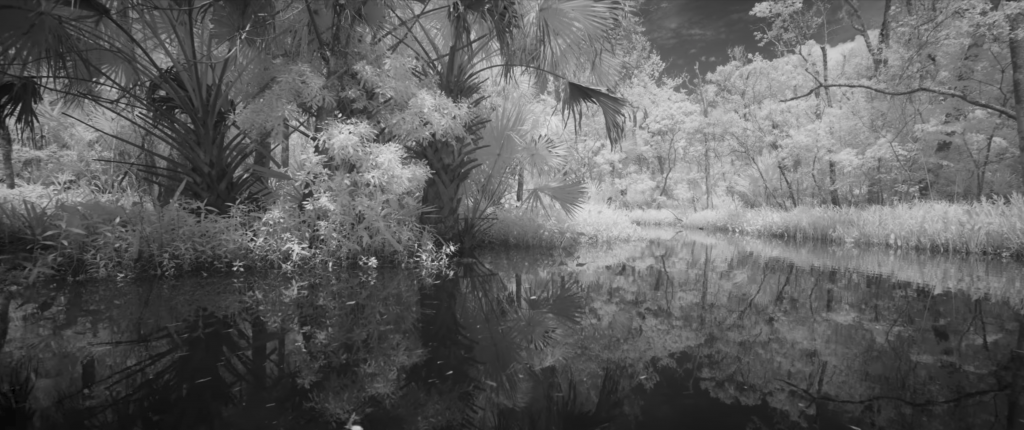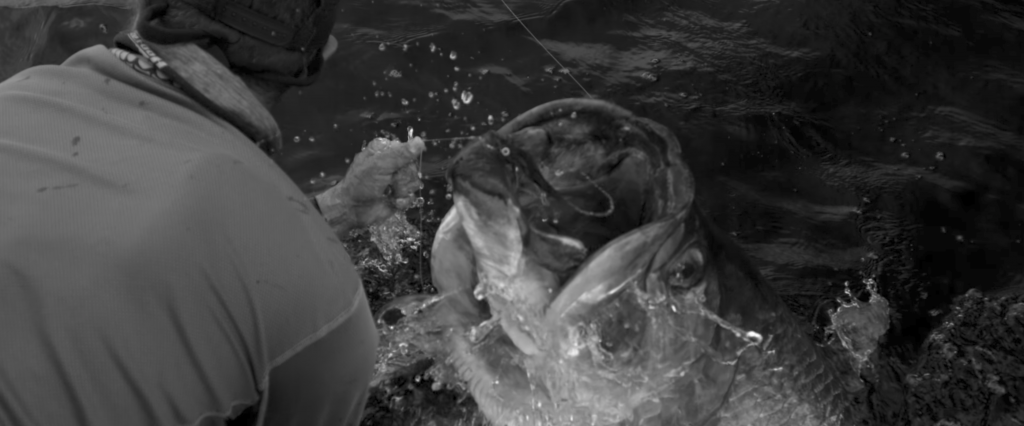Full disclosure: I’m a sucker for fishing stories.
Highlighting unique characters and their most colorful sound bites is key to Felt Soul Media’s short film 120 Days: Tarpon Season. Yeti Coolers sponsors this film about David Mangum, a fly-fishing guide obsessed with tarpon fishing in the coastal Florida Everglades. In less than 8 minutes, this film offers a solid example of branded content that doesn’t feel anything like an advertisement. It blends visual eye candy with characterization and storytelling.
The film opens with the positive action using a mounting move as the camera (I assume mounted on a boat) moves down a channel in an Everglades swamp, inviting the viewer into a story with a beautiful and intriguing setting. Giant palm fronds place the viewer somewhere in the South. The filmmakers fade in the natural sound of a chorus of insects simultaneously with the picture to hook the viewer.
I love that the film is shot in black and white to accentuate the light and shadow of both the outdoor shoots and interviews. At 0:33, Mangum says in his interview that tarpon fishing has “grayed out everything else, more so than anything else in my life,” which builds on the significance of the choice to forego the vibrant colors of the environment.
I’m intrigued by the composition of the primary interview with Mangum. At 0:35, the filmmakers first show the interview with him in the right third of the frame looking to the right of the camera, leaving little talk space. They’re also punched in tight on his face, with picture cropping off his head just above his eyebrows. At 4:00 however, we see more of Mangum. He’s sitting upright and animated, he’s positioned in the left third of the frame and his eyes are aligned with the upper third. It could be construed that the more we get to know this somewhat surly character, the more his face and his personality are revealed.
To convey that Mangum’s approach to guiding for tarpon is obsessive, the string score builds up a sense of frenetic energy, and quick cuts showing various scenes playing in reverse effectively generate tension. It’s pretty brilliant how Mangum’s swirling hand motions around his head act like a recorder winding tape back to set the video in reverse (1:23).
The tone of the video shifts at 4:33 as we segue from describing Mangum’s obsessive preparation and the pursuit of tarpon, to describing the payoff; the thrill of having a tarpon on the line. We start to see longer clips and the pace of both the footage and the cuts slow down. The artful cinematography of birds flying and a tarpon jumping (4:34-4:50) are captured at a frame rate of 1,000 frames per second with a Phantom Flex4K camera.
Despite the pacing of the action slowing way down, the three interviews are cut together in quick succession. Each individual contributes to the description of the sheer exhilaration that comes with the sight and feeling of having a tarpon on your fly line. That shared experience speaks to the bonds felt in fishing culture. The piano score of “Where is my Mind” not only adds a layer of elegance to the cinematography, but it counterbalances the manic nature of the earlier part of the film. This gets to lure of all fishing. Fish are elusive, and the time and energy it takes to present a fly to a fish can be all-consuming, even maddening, but the rush of having a fish on the line makes it all worthwhile.
At 5:32, we see a close-up shot that would never have happened it the videographer wasn’t comfortable getting as tight as possible over the subject’s shoulder. I recently learned that the filmmakers, Travis and Ben, shot for two weeks and saw only one tarpon. If they weren’t ready for this shot, they might not have been able to pull the video off.
I was most struck by the way the video is buoyed and balanced by the humor offered by a secondary character, Brett Martina, a shit-talking guide with a thick South-Florida draw, who provides light moments in a story about a man who is pretty rough around the edges. I think that without this interview, the story would have been too somber. The black and white footage and montages set to piano music may have come off as an overly dramatic for a fishing video. Brett lends some needed levity. I appreciate that the filmmakers break the fourth wall frequently during Brett’s interview because his personality comes through best as he interacts with them.
No matter how impressive the shots are, and many of these are truly great, any fishing video gets boring fast unless we get to connect with the people in the story. While we begin the film thinking we’re about to get to know David Mangum, the film concludes with the viewer feeling a little closer to Brett, who even provides the concluding statement on David’s story.




Leave a Reply